4.2: Proper Fractions, Improper Fractions, and Mixed Numbers
- Page ID
- 48851
\( \newcommand{\vecs}[1]{\overset { \scriptstyle \rightharpoonup} {\mathbf{#1}} } \)
\( \newcommand{\vecd}[1]{\overset{-\!-\!\rightharpoonup}{\vphantom{a}\smash {#1}}} \)
\( \newcommand{\id}{\mathrm{id}}\) \( \newcommand{\Span}{\mathrm{span}}\)
( \newcommand{\kernel}{\mathrm{null}\,}\) \( \newcommand{\range}{\mathrm{range}\,}\)
\( \newcommand{\RealPart}{\mathrm{Re}}\) \( \newcommand{\ImaginaryPart}{\mathrm{Im}}\)
\( \newcommand{\Argument}{\mathrm{Arg}}\) \( \newcommand{\norm}[1]{\| #1 \|}\)
\( \newcommand{\inner}[2]{\langle #1, #2 \rangle}\)
\( \newcommand{\Span}{\mathrm{span}}\)
\( \newcommand{\id}{\mathrm{id}}\)
\( \newcommand{\Span}{\mathrm{span}}\)
\( \newcommand{\kernel}{\mathrm{null}\,}\)
\( \newcommand{\range}{\mathrm{range}\,}\)
\( \newcommand{\RealPart}{\mathrm{Re}}\)
\( \newcommand{\ImaginaryPart}{\mathrm{Im}}\)
\( \newcommand{\Argument}{\mathrm{Arg}}\)
\( \newcommand{\norm}[1]{\| #1 \|}\)
\( \newcommand{\inner}[2]{\langle #1, #2 \rangle}\)
\( \newcommand{\Span}{\mathrm{span}}\) \( \newcommand{\AA}{\unicode[.8,0]{x212B}}\)
\( \newcommand{\vectorA}[1]{\vec{#1}} % arrow\)
\( \newcommand{\vectorAt}[1]{\vec{\text{#1}}} % arrow\)
\( \newcommand{\vectorB}[1]{\overset { \scriptstyle \rightharpoonup} {\mathbf{#1}} } \)
\( \newcommand{\vectorC}[1]{\textbf{#1}} \)
\( \newcommand{\vectorD}[1]{\overrightarrow{#1}} \)
\( \newcommand{\vectorDt}[1]{\overrightarrow{\text{#1}}} \)
\( \newcommand{\vectE}[1]{\overset{-\!-\!\rightharpoonup}{\vphantom{a}\smash{\mathbf {#1}}}} \)
\( \newcommand{\vecs}[1]{\overset { \scriptstyle \rightharpoonup} {\mathbf{#1}} } \)
\( \newcommand{\vecd}[1]{\overset{-\!-\!\rightharpoonup}{\vphantom{a}\smash {#1}}} \)
Learning Objectives
- be able to distinguish between proper fractions, improper fractions, and mixed numbers
- be able to convert an improper fraction to a mixed number
- be able to convert a mixed number to an improper fraction
Now that we know what positive fractions are, we consider three types of positive fractions: proper fractions, improper fractions, and mixed numbers.
Positive Proper Fractions
Definition: Positive Proper Fraction
Fractions in which the whole number in the numerator is strictly less than the whole number in the denominator are called positive proper fractions. On the number line, proper fractions are located in the interval from 0 to 1. Positive proper fractions are always less than one.

The closed circle at 0 indicates that 0 is included, while the open circle at 1 indicates that 1 is not included.
Some examples of positive proper fractions are
\(\dfrac{1}{2}\), \(\dfrac{3}{5}\), \(\dfrac{20}{27}\), and \(\dfrac{106}{255}\)
Note that \(1 < 2\), \(3 < 5\), \(20 < 27\), and \(106 < 225\).
Positive Improper Fractions
Definition: Positive Improper Fractions
Fractions in which the whole number in the numerator is greater than or equal to the whole number in the denominator are called positive improper fractions. On the number line, improper fractions lie to the right of (and including) 1. Positive improper fractions are always greater than or equal to 1.

Some examples of positive improper fractions are
\(\dfrac{3}{2}\), \(\dfrac{8}{5}\), \(\dfrac{4}{4}\), and \(\dfrac{105}{16}\)
Note that \(3 \ge 2, 8 \ge 5, 4 \ge 4\), and \(105 \ge 16\).
Positive Mixed Numbers
Definition: Positive Mixed Numbers
A number of the form \(\text{nonzero whole number} + \text{proper fraction}\) is called a positive mixed number. For example, 2\(\dfrac{3}{5}\) is a mixed number. On the number line, mixed numbers are located in the interval to the right of (and including) 1. Mixed numbers are always greater than or equal to 1.

Relating Positive Improper Fractions and Positive Mixed Numbers
A relationship between improper fractions and mixed numbers is suggested by two facts. The first is that improper fractions and mixed numbers are located in the same interval on the number line. The second fact, that mixed numbers are the sum of a natural number and a fraction, can be seen by making the following observations.
Divide a whole quantity into 3 equal parts.

Now, consider the following examples by observing the respective shaded areas.

In the shaded region, there are 2 one thirds, or \(\dfrac{2}{3}\).
\(2 (\dfrac{1}{3}) = \dfrac{2}{3}\)

There are 3 one thirds, or \(\dfrac{3}{3}\), or 1.
\(3(\dfrac{1}{3}) = \dfrac{3}{3}\) or 1
Thus,
\(\dfrac{3}{3} = 1\)
Improper fraction = whole number.


There are 4 one thirds, or \(\dfrac{4}{3}\), or 1 and \(\dfrac{1}{3}\).
\(4(\dfrac{1}{3}) = \dfrac{4}{3}\) or 1 and \(\dfrac{1}{3}\)
The terms 1 and \(\dfrac{1}{3}\) can be represented as \(1 + \dfrac{1}{3}\) or \(1 \dfrac{1}{3}\)
Thus,
\(\dfrac{4}{3} = 1 \dfrac{1}{3}.\)
mproper fraction = mixed number.


There are 5 one thirds, or \(\dfrac{5}{3}\), or 1 and \(\dfrac{2}{3}\).
\(5(\dfrac{1}{3}) = \dfrac{5}{3}\) or 1 and \(\dfrac{2}{3}\)
The terms 1 and \(\dfrac{2}{3}\) can be represented as \(1 + \dfrac{2}{3}\) or \(1\dfrac{2}{3}\).
Thus,
\(\dfrac{5}{3} = 1 \dfrac{2}{3}\).
Improper fraction = mixed number.


There are 6 one thirds, or \(\dfrac{6}{3}\), or 2.
\(6(\dfrac{1}{3}) = \dfrac{6}{3} = 2\)
Thus,
\(\dfrac{6}{3} = 2\)
Improper fraction = whole number.
The following important fact is illustrated in the preceding examples.
Mixed Number = Natural Number + Proper Fraction
Mixed numbers are the sum of a natural number and a proper fraction. Mixed number = (natural number) + (proper fraction)
For example \(1 \dfrac{1}{3}\) can be expressed as \(1 + \dfrac{1}{3}\) The fraction \(5 \dfrac{7}{8}\) can be expressed as \(5 + \dfrac{7}{8}\).
It is important to note that a number such as \(5 + \dfrac{7}{8}\) does not indicate multiplication. To indicate multiplication, we would need to use a multiplication symbol (such as \(\cdot\))
Example \(\PageIndex{1}\)
\(5 \dfrac{7}{8}\) means \(5 + \dfrac{7}{8}\) and not \(5 \cdot \dfrac{7}{8}\), which means 5 times \(\dfrac{7}{8}\) or 5 multiplied by \(\dfrac{7}{8}\).
Thus, mixed numbers may be represented by improper fractions, and improper fractions may be represented by mixed numbers.
Converting Improper Fractions to Mixed Numbers
To understand how we might convert an improper fraction to a mixed number, let's consider the fraction, \(\dfrac{4}{3}\).
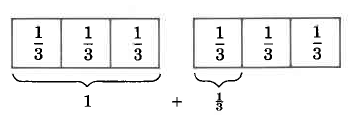
\(\begin{array} {rcl} {\dfrac{4}{3}} & = & {\underbrace{\dfrac{1}{3} + \dfrac{1}{3} + \dfrac{1}{3}}_{1} + \dfrac{1}{3}} \\ {} & = & {1 + \dfrac{1}{3}} \\ {} & = & {1\dfrac{1}{3}} \end{array}\)
We can illustrate a procedure for converting an improper fraction to a mixed number using this example. However, the conversion is more easily accomplished by dividing the numerator by the denominator and using the result to write the mixed number.
Converting an Improper Fraction to a Mixed Number
To convert an improper fraction to a mixed number, divide the numerator by the denominator.
The whole number part of the mixed number is the quotient.
The fractional part of the mixed number is the remainder written over the divisor (the denominator of the improper fraction).
Sample Set A
Convert each improper fraction to its corresponding mixed number.
\(\dfrac{5}{3}\) Divide 5 by 3.
Solution
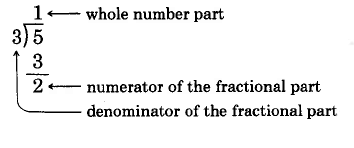
The improper fraction \(\dfrac{5}{3} = 1 \dfrac{2}{3}\).

Sample Set A
\(\dfrac{46}{9}\) Divide 46 by 9.
Solution
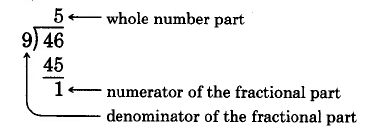
The improper fraction \(\dfrac{46}{9} = 5 \dfrac{1}{9}\).

Sample Set A
\(\dfrac{83}{11}\) Divide 83 by 11.
Solution
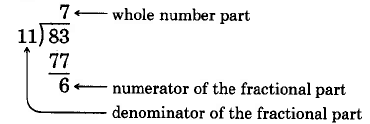
The improper fraction \(\dfrac{83}{11} = 7 \dfrac{6}{11}\).

Sample Set A
\(\dfrac{104}{4}\) Divide 104 by 4.
Solution
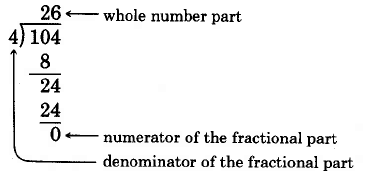
\(\dfrac{104}{4} = 26 \dfrac{0}{4} = 26
The improper fraction \(\dfrac{104}{4} = 26\).

Practice Set A
Convert each improper fraction to its corresponding mixed number.
\(\dfrac{9}{2}\)
- Answer
-
\(4\dfrac{1}{2}\)
Practice Set A
\(\dfrac{11}{3}\)
- Answer
-
\(3\dfrac{2}{3}\)
Practice Set A
\(\dfrac{14}{11}\)
- Answer
-
\(1\dfrac{3}{11}\)
Practice Set A
\(\dfrac{31}{13}\)
- Answer
-
\(2\dfrac{5}{13}\)
Practice Set A
\(\dfrac{79}{4}\)
- Answer
-
\(19\dfrac{3}{4}\)
Practice Set A
\(\dfrac{496}{8}\)
- Answer
-
62
Converting Mixed Numbers to Improper Fractions
To understand how to convert a mixed number to an improper fraction, we'll recall
mixed number = (natural number) + (proper fraction)
and consider the following diagram.


Recall that multiplication describes repeated addition.
Notice that \(\dfrac{5}{3}\) can be obtained from \(1 \dfrac{2}{3}\) using multiplication in the following way.
Multiply: \(3 \cdot 1 = 3\)
![]()
Add: \(3 + 2 = 5\). Place the 5 over the 3: \(\dfrac{5}{3}\)
The procedure for converting a mixed number to an improper fraction is illustrated in this example.
Converting a Mixed Number to an Improper Fraction
To convert a mixed number to an improper fraction,
Multiply the denominator of the fractional part of the mixed number by the whole number part.
To this product, add the numerator of the fractional part.
Place this result over the denominator of the fractional part.
Sample Set B
Convert each mixed number to an improper fraction.
\(5 \dfrac{7}{8}\)
Solution
- Multiply: \(8 \cdot 5 = 40\)
- Add: \(40 + 7 = 47\)
- Place 47 over 8: \(\dfrac{47}{8}\)
Thus, \(5 \dfrac{7}{8} = \dfrac{47}{8}\).

Sample Set B
\(16 \dfrac{2}{3}\)
Solution
- Multiply: \(3 \cdot 16 = 48\).
- Add: \(48 + 2 = 50\)
- Place 50 over 3: \(\dfrac{50}{3}\)
Thus, \(16 \dfrac{2}{3} = \dfrac{50}{3}\)
Practice Set A
Convert each mixed number to its corresponding improper fraction.
\(8 \dfrac{1}{4}\)
- Answer
-
\(\dfrac{33}{4}\)
Practice Set A
\(5 \dfrac{3}{5}\)
- Answer
-
\(\dfrac{28}{5}\)
Practice Set A
\(1 \dfrac{4}{15}\)
- Answer
-
\(\dfrac{19}{15}\)
Practice Set A
\(12 \dfrac{2}{7}\)
- Answer
-
\(\dfrac{86}{7}\)
Exercises
For the following 15 problems, identify each expression as a proper fraction, an improper fraction, or a mixed number.
Exercise \(\PageIndex{1}\)
\(\dfrac{3}{2}\)
- Answer
-
improper fraction
Exercise \(\PageIndex{2}\)
\(\dfrac{4}{9}\)
Exercise \(\PageIndex{3}\)
\(\dfrac{5}{7}\)
- Answer
-
proper fraction
Exercise \(\PageIndex{4}\)
\(\dfrac{1}{8}\)
Exercise \(\PageIndex{5}\)
\(6 \dfrac{1}{4}\)
- Answer
-
mixed number
Exercise \(\PageIndex{6}\)
\(\dfrac{11}{8}\)
Exercise \(\PageIndex{7}\)
\(\dfrac{1,001}{12}\)
- Answer
-
improper fraction
Exercise \(\PageIndex{8}\)
\(191 \dfrac{4}{5}\)
Exercise \(\PageIndex{9}\)
\(1 \dfrac{9}{13}\)
- Answer
-
mixed number
Exercise \(\PageIndex{10}\)
\(31 \dfrac{6}{7}\)
Exercise \(\PageIndex{11}\)
\(3 \dfrac{1}{40}\)
- Answer
-
mixed number
Exercise \(\PageIndex{12}\)
\(\dfrac{55}{12}\)
Exercise \(\PageIndex{13}\)
\(\dfrac{0}{9}\)
- Answer
-
proper fraction
Exercise \(\PageIndex{14}\)
\(\dfrac{8}{9}\)
Exercise \(\PageIndex{15}\)
\(101 \dfrac{1}{11}\)
- Answer
-
mixed number
For the following 15 problems, convert each of the improper fractions to its corresponding mixed number.
Exercise \(\PageIndex{16}\)
\(\dfrac{11}{6}\)
Exercise \(\PageIndex{17}\)
\(\dfrac{14}{3}\)
- Answer
-
\(4 \dfrac{2}{3}\)
Exercise \(\PageIndex{18}\)
\(\dfrac{25}{4}\)
Exercise \(\PageIndex{19}\)
\(\dfrac{35}{4}\)
- Answer
-
\(8 \dfrac{3}{4}\)
Exercise \(\PageIndex{20}\)
\(\dfrac{71}{8}\)
Exercise \(\PageIndex{21}\)
\(\dfrac{63}{7}\)
- Answer
-
9
Exercise \(\PageIndex{22}\)
\(\dfrac{121}{11}\)
Exercise \(\PageIndex{23}\)
\(\dfrac{165}{12}\)
- Answer
-
\(13 \dfrac{9}{12}\) or \(13 \dfrac{3}{4}\)
Exercise \(\PageIndex{24}\)
\(\dfrac{346}{15}\)
Exercise \(\PageIndex{25}\)
\(\dfrac{5,000}{9}\)
- Answer
-
\(555 \dfrac{5}{9}\)
Exercise \(\PageIndex{26}\)
\(\dfrac{23}{5}\)
Exercise \(\PageIndex{27}\)
\(\dfrac{73}{2}\)
- Answer
-
\(36 \dfrac{1}{2}\)
Exercise \(\PageIndex{28}\)
\(\dfrac{19}{2}\)
Exercise \(\PageIndex{29}\)
\(\dfrac{316}{41}\)
- Answer
-
\(7 \dfrac{29}{41}\)
Exercise \(\PageIndex{30}\)
\(\dfrac{800}{3}\)
For the following 15 problems, convert each of the mixed numbers to its corresponding improper fraction.
Exercise \(\PageIndex{31}\)
\(4 \dfrac{1}{8}\)
- Answer
-
\(\dfrac{33}{8}\)
Exercise \(\PageIndex{32}\)
\(1 \dfrac{5}{12}\)
Exercise \(\PageIndex{33}\)
\(6 \dfrac{7}{9}\)
- Answer
-
\(\dfrac{61}{9}\)
Exercise \(\PageIndex{34}\)
\(15 \dfrac{1}{4}\)
Exercise \(\PageIndex{35}\)
\(10 \dfrac{5}{11}\)
- Answer
-
\(\dfrac{115}{11}\)
Exercise \(\PageIndex{36}\)
\(15 \dfrac{3}{10}\)
Exercise \(\PageIndex{37}\)
\(8 \dfrac{2}{3}\)
- Answer
-
\(\dfrac{26}{3}\)
Exercise \(\PageIndex{38}\)
\(4 \dfrac{3}{4}\)
Exercise \(\PageIndex{39}\)
\(21 \dfrac{2}{5}\)
- Answer
-
\(\dfrac{107}{5}\)
Exercise \(\PageIndex{40}\)
\(17 \dfrac{9}{10}\)
Exercise \(\PageIndex{41}\)
\(9 \dfrac{20}{21}\)
- Answer
-
\(\dfrac{209}{21}\)
Exercise \(\PageIndex{42}\)
\(5 \dfrac{1}{16}\)
Exercise \(\PageIndex{43}\)
\(90 \dfrac{1}{100}\)
- Answer
-
\(\dfrac{9001}{100}\)
Exercise \(\PageIndex{44}\)
\(300 \dfrac{43}{1,000}\)
Exercise \(\PageIndex{45}\)
\(19 \dfrac{7}{8}\)
- Answer
-
\(\dfrac{159}{8}\)
Exercise \(\PageIndex{46}\)
Why does \(0 \dfrac{4}{7}\) not qualify as a mixed number?
Hint:
See the definition of a mixed number.
Exercise \(\PageIndex{47}\)
Why does 5 qualify as a mixed number?
Hint:
See the definition of a mixed number.
- Answer
-
... because it may be wirtten as \(5 \dfrac{0}{n}\), where \(n\) is any positive whole number.
Calculator Problems
For the following 8 problems, use a calculator to convert each mixed number to its corresponding improper fraction.
Exercise \(\PageIndex{48}\)
\(35 \dfrac{11}{12}\)
Exercise \(\PageIndex{49}\)
\(27 \dfrac{5}{61}\)
- Answer
-
\(\dfrac{1,652}{61}\)
Exercise \(\PageIndex{50}\)
\(83 \dfrac{40}{41}\)
Exercise \(\PageIndex{51}\)
\(105 \dfrac{21}{23}\)
- Answer
-
\(\dfrac{2,436}{23}\)
Exercise \(\PageIndex{52}\)
\(72 \dfrac{605}{606}\)
Exercise \(\PageIndex{53}\)
\(816 \dfrac{19}{25}\)
- Answer
-
\(\dfrac{20,419}{25}\)
Exercise \(\PageIndex{54}\)
\(708 \dfrac{42}{51}\)
Exercise \(\PageIndex{55}\)
\(6,012 \dfrac{4,216}{8,117}\)
- Answer
-
\(\dfrac{48,803,620}{8,117}\)
Exercises For Review
Exercise \(\PageIndex{56}\)
Round 2,614,000 to the nearest thousand.
Exercise \(\PageIndex{57}\)
Find the product. \(1,004 \cdot 1,005\)
- Answer
-
1,009,020
Exercise \(\PageIndex{58}\)
Determine if 41,826 is divisible by 2 and 3.
Exercise \(\PageIndex{59}\)
Find the least common multiple of 28 and 36.
- Answer
-
252
Exercise \(\PageIndex{60}\)
Specify the numerator and denominator of the fraction \(\dfrac{12}{19}\).


